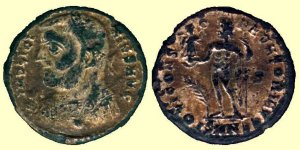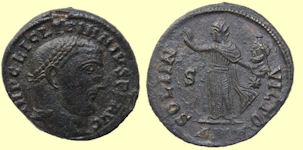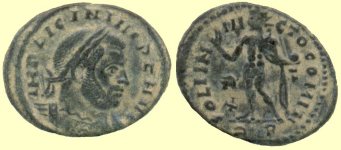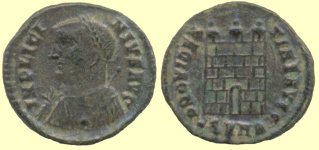
Licinius 308 - 324 A.D.
By clicking on the pictures you'll be linked to a more complete description of the coin. At the bottom of this page there is a more elaborate biography of the emperor.
 |
Obverse: IMP LICINIVS AVG |
| Reverse: IOVI CONSERVATORI AVGG | |
|
Fieldmarks: an S in the right field
|
|
| Exergue: SMN |
 |
Obverse: IMP C LIC LICINNIVS PF AVG |
| Reverse: SOLI INVICTO | |
|
Fieldmarks: S in the left field and a star
|
|
| Exergue: ANT |
 |
Obverse: IMP LICINIVS PF AVG |
| Reverse: SOLI INVICTO COMITI | |
|
Fieldmarks: R over X in the left field and F in the right
field
|
|
| Exergue: R P |
 |
Obverse: IMP LICINIVS AVG |
| Reverse: PROVIDENTIAE AVGG | |
|
Fieldmarks: -
|
|
| Exergue: |
Licinius 308 - 324 A.D.
As soon as Maximinus
Daia learned about the marital alliance between Licinius and Constantine
and the death of Maxentius, who had been his ally, he quickly moved his army
trough a wintery Asia
minor and, in April 313, crossed the Bosporus
and went to Byzantium,
which he took from Licinius after an eleven day siege. On the 30th of April
313 the armies of both emperors clashed on the Campus
Ergenus but Maximinus Daia's troops who had been quickly driven across wintery
and snow bound Asia
Minor were on the brink exhaustion. Despite their highly superior numbers
they were defeated by Licinius. Maximinus II Daia retreated back to Asia Minor,
and withdrew behind the Taurus
mountains to Tarsus.
First Licinius moved to Nicomedia
where he promulgated the Edict of Milan granting complete freedom of worship
to all Christians. A last ditch stand by Daia at the Cilician
Gates failed and Maximinus II either succumbed to serious illness or took
poison around August of 313 AD. Once Licinius had defeated Maximinus
Daia he gained all his territories and was welcomed by its people who where
glad to be rid of the ruthless dictator Maximinus. Now Licinius and Constantine
where the sole rulers of the Roman world.
Constantine and Licinius didn't like each
other very much and it was clear that both wanted to became the sole ruler of
the roman empire. In the following years they fought two smaller battles. First
Constantine's forces joined battle with those of Licinius at Cibalae
in Pannonia
on the 8th of October 314. Constantine prevailed, his victory, however was a
hollow one because both sites lost a lot of man. Both emperors had also been
involved in exhausting military campaigns in the previous year and the months
leading up to Cibalae
and each of their realms had expanded so fast that their manpower must have
been stretched to the limit. Both men retreated to their own territory to lick
their wounds and the status quo between the two was restored. Although not much
else is known about Licinius' activities during this period, it is very likely
that he spent much of his time preparing for his impending war against Constantine.
Sometime between the 1st of December and the 28th of February 317, both emperors'
armies joined in battle again this time on the Campus
Ardiensis. Just before the battle Licinius gave his general of the Illyrian
frontier, Valens the precarious title of Caesar. Constantine's forces were victorious
once again and on the 1st of March 317, both sides agreed to a cessation of
hostilities, Licinius was able to keep his throne, although he had to agree
to the execution of his colleague Valens (who had only ruled for a few days).
Licinius also had to give a large part of his territories to his brother-in-law
namely Pannonia,
Illyricum,
Macedonia
and Greece.
Licinius turned on the Christians in his realm seemingly in 320 AD. The first law that Licinius issued prevented bishops from communicating with each other and from holding synods to discuss matters of interest to them. The second law prohibited men and women from attending services together and young girls from receiving instruction from their bishop or schools. When this law was issued, he also gave orders that Christians could hold services only outside the city walls additionally, he deprived officers in the army of their commissions if they did not sacrifice to the Roman gods. Licinius may have been trying to incite Constantine (who was said to be a devote Christian) to attack him. Over the years Constantine had greatly solidified his hold over the West and had won several great victories over the barbarians at the Danube border. With all these victories he could no longer tolerate the aging and weak emperor of the East and having assembled a great fleet and army (120000 infantry and 10000 cavalry) at Thessalonica, Constantine advanced toward Adrianopolis. Licinius who was still a great general assembled a huge army (150000 infantry and 15000 cavalry) and fleet of his own (to the surprise of his enemy) and engaged the forces of his brother-in-law near the banks of the Hebrus River on the 3th of July 324 where his forces were routed. With as many men as he could gather, Licinius headed for his fleet in the Hellespont and fled to Byzantium, where he was besieged by Constantine. Licinius' fleet, under the command of the admiral Abantus, was overcome by bad weather and by Constantine' s fleet which was under the command of his son Crispus. Now hard pressed in Byzantium, Licinius abandoned the city to his rival and fled to Chalcedon in Bithynia. Leaving Martinianus, his former magister officiorum and now his co-ruler, to impede Constantine's progress, Licinius regrouped his forces and engaged his enemy with great valor and desperation at Chrysopolis where he lost some 15000 man and was again routed on the 18th of September 324. He fled to Nicomedia which Constantine began to besiege, on the second day of the siege Licinius abdicated and was sent to Thessalonica, where he was kept under house arrest. Martinianus may have been put to death before the end of 324, whereas Licinius was not put to death until the spring of 325. Rumors circulated that Licinius had been put to death because he attempted a rebellion against Constantine by allying himself with the Goths. Eventually his son Licinius the Younger was also executed in 327 AD.
For this biography I've used the texts from the following websites:
http://www.imperiumromanum.com/
http://www.roman-emperors.org/
http://www.roman-empire.net/
And from: Gibbon's Decline and fall of the Roman empire.